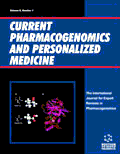- Home
- A-Z Publications
- Current Pharmacogenomics and Personalized Medicine (Formerly Current Pharmacogenomics)
- Issue Home
Current Pharmacogenomics and Personalized Medicine (Formerly Current Pharmacogenomics) - Current Issue
Volume 21, Issue 3, 2024
-
-
Deciphering the Genetic Landscape: Exploring the Relationship Between HLA-DQA1, HLA-DQB1, and HLA-DRB1 Genes in Diabetes Mellitus
More LessDiabetes mellitus (DM) is a complex and multifactorial metabolic disorder with a significant genetic component. The human leukocyte antigen (HLA) genes, specifically HLA-DQA1, HLA-DQB1, and HLA-DRB1, have been implicated in the susceptibility and pathogenesis of DM. This review delves into the intricate interplay of these HLA genes, seeking to unravel the genetic tapestry that contributes to the development and progression Read More
-
-
-
Comparative Study on the Genetic Architecture of Type 2 Diabetes in Indian and Other Ethnic Groups: A Review
More LessAuthors: Jyotsna Singh, Vijay Tripathi, Nachimuthu Senthil Kumar, Rajiv Kant and Jonathan A. LalType 2 diabetes mellitus (T2DM) is a condition of metabolism that impacts people worldwide regardless of country, age group, and gender. In addition to a sedentary lifestyle, genetic susceptibility, specifically single nucleotide polymorphisms, is implicated in the emergence and progression of T2DM. This study compares the genetic variants of the Indian population with three other ethnic cohorts: African, European, and Chin Read More
-
-
-
Understanding Bacterial Roles in Cancer Chemo-resistance: A Signaling Pathway Mapping Study
More LessIntroductionChemoresistance is one of the leading causes of chemotherapy failure among cancer patients. Out of several hypotheses proposed for chemoresistance, bacteria-mediated chemoresistance to cancer drugs has not been well established. Thus, the aim of this review is to map the pathways by which bacteria exhibit chemoresistance in specific cancers.Material and MethodsRelevant articles on bacteria-mediated ch Read More
-
-
-
Ancestry-Related Differences in Allele and Genotype Frequencies of EGF A61G Polymorphism in the Cuban Population
More LessBackgroundThe polymorphism rs4444903 of the Epidermal Growth Factor gene (EGF A61G) causes differences in the EGF serum levels. It has become a biomarker for genetic susceptibility to cancer and a pharmacogenomic marker for therapies involving the EGF/EGF-receptor pathway.ObjectiveThe present study aimed to characterize the allele and genotype frequencies of the rs4444903 in a Cuban sample and Read More
-
-
-
Decoding Multidrug Resistance: Genetic Architecture and Codon Usage Patterns in ESKAPE Pathogens
More LessAuthors: Ujwal Dahal, Anu Bansal and Dheeraj ChitaraIntroductionThe escalating challenge of multidrug resistance among ESKAPE pathogens has become a prominent concern for global healthcare providers, leading to amplified morbidity and mortality rates.MethodsWe conducted this study to elucidate the genetic architecture of ESKAPE constituents with the intent of ameliorating pathogenicity and facilitating drug development efforts. A comprehensive array of computati Read More
-
Volumes & issues
Most Read This Month Most Read RSS feed
Article
content/journals/cppm
Journal
10
5
false
en


